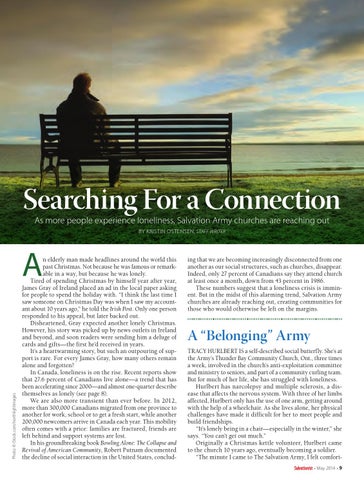TIES THAT BIND
Searching For a Connection As more people experience loneliness, Salvation Army churches are reaching out BY KRISTIN OSTENSEN, STAFF WRITER
Photo: © iStock.com/northlightimages
A
n elderly man made headlines around the world this past Christmas. Not because he was famous or remarkable in a way, but because he was lonely. Tired of spending Christmas by himself year after year, James Gray of Ireland placed an ad in the local paper asking for people to spend the holiday with. “I think the last time I saw someone on Christmas Day was when I saw my accountant about 10 years ago,” he told the Irish Post. Only one person responded to his appeal, but later backed out. Disheartened, Gray expected another lonely Christmas. However, his story was picked up by news outlets in Ireland and beyond, and soon readers were sending him a deluge of cards and gifts—the first he’d received in years. It’s a heartwarming story, but such an outpouring of support is rare. For every James Gray, how many others remain alone and forgotten? In Canada, loneliness is on the rise. Recent reports show that 27.6 percent of Canadians live alone—a trend that has been accelerating since 2000—and almost one-quarter describe themselves as lonely (see page 8). We are also more transient than ever before. In 2012, more than 300,000 Canadians migrated from one province to another for work, school or to get a fresh start, while another 200,000 newcomers arrive in Canada each year. This mobility often comes with a price: families are fractured, friends are left behind and support systems are lost. In his groundbreaking book Bowling Alone: The Collapse and Revival of American Community, Robert Putnam documented the decline of social interaction in the United States, conclud-
ing that we are becoming increasingly disconnected from one another as our social structures, such as churches, disappear. Indeed, only 27 percent of Canadians say they attend church at least once a month, down from 43 percent in 1986. These numbers suggest that a loneliness crisis is imminent. But in the midst of this alarming trend, Salvation Army churches are already reaching out, creating communities for those who would otherwise be left on the margins.
A “Belonging” Army
TRACY HURLBERT IS a self-described social butterfly. She’s at the Army’s Thunder Bay Community Church, Ont., three times a week, involved in the church’s anti-exploitation committee and ministry to seniors, and part of a community curling team. But for much of her life, she has struggled with loneliness. Hurlbert has narcolepsy and multiple sclerosis, a disease that affects the nervous system. With three of her limbs affected, Hurlbert only has the use of one arm, getting around with the help of a wheelchair. As she lives alone, her physical challenges have made it difficult for her to meet people and build friendships. “It’s lonely being in a chair—especially in the winter,” she says. “You can’t get out much.” Originally a Christmas kettle volunteer, Hurlbert came to the church 10 years ago, eventually becoming a soldier. “The minute I came to The Salvation Army, I felt comfortSalvationist • May 2014 • 9
